New Benzo[h]quinolin-10-ol Derivatives as Co-sensitizers for DSSCs
Abstract
1. Introduction
2. Experimental
2.1. Computational Details
2.2. Synthesis of Cyanoacrylic Acids 10-Hydroxobenzo[h]Quinoline Derivatives
3. Results and Discussion
3.1. Synthesis, Thermal, Optical and Electrochemical Characterization
3.2. Computational Studies
3.2.1. Importance of Co-Adsorbents Chemical Structure
3.2.2. Dye and Dye-TiO2 System Geometry Optimizations and Frontier Molecular Orbitals Energy Determination
3.3. DSSCs Characterization
3.3.1. Photoanode Thickness and Morphology
3.3.2. Photovoltaic Properties of Devices
4. Conclusions
Supplementary Materials
Author Contributions
Funding
Institutional Review Board Statement
Informed Consent Statement
Data Availability Statement
Acknowledgments
Conflicts of Interest
References
- Grätzel, M. Recent advances in sensitized mesoscopic solar cells. Acc. Chem. Res. 2009, 42, 1788–1798. [Google Scholar] [CrossRef]
- Shakeel Ahmad, M.; Pandey, A.K.; Abd Rahim, N. Advancements in the development of TiO2 photoanodes and its fabrication methods for dye sensitized solar cell (DSSC) applications. A review. Renew. Sustain. Energy Rev. 2017, 77, 89–108. [Google Scholar] [CrossRef]
- Breyer, C.; Bogdanov, D.; Aghahosseini, A.; Gulagi, A.; Child, M.; Oyewo, A.S.; Farfan, J.; Sadovskaia, K.; Vainikka, P. Solar photovoltaics demand for the global energy transition in the power sector. Prog. Photovolt. Res. Appl. 2018, 26, 505–523. [Google Scholar] [CrossRef]
- Naik, P.; Elmorsy, M.R.; Su, R.; Babu, D.D.; El-Shafei, A.; Adhikari, A.V. New carbazole based metal-free organic dyes with D-π-A-π-A architecture for DSSCs: Synthesis, theoretical and cell performance studies. Sol. Energy 2017, 153, 600–610. [Google Scholar] [CrossRef]
- O’Regan, B.; Grätzel, M. A low-cost, high-efficiency solar cell based on dye-sensitized colloidal TiO2 films. Nature 1991, 354, 737–740. [Google Scholar] [CrossRef]
- Lee, C.P.; Li, C.T.; Ho, K.C. Use of organic materials in dye-sensitized solar cells. Mater. Today 2017, 20, 267–283. [Google Scholar] [CrossRef]
- Wu, Z.S.; Song, X.C.; Liu, Y.D.; Zhang, J.; Wang, H.S.; Chen, Z.J.; Liu, S.; Weng, Q.; An, Z.W.; Guo, W.J. New organic dyes with varied arylamine donors as effective co-sensitizers for ruthenium complex N719 in dye sensitized solar cells. J. Power Sources 2020, 451, 227776. [Google Scholar] [CrossRef]
- Hagfeldt, A.; Boschloo, G.; Sun, L.; Kloo, L.; Pettersson, H. Dye-Sensitized Solar Cells. Chem. Rev. 2010, 110, 6595–6663. [Google Scholar] [CrossRef]
- Johnson, N.M.; Smolin, Y.Y.; Hagaman, D.; Soroush, M.; Lau KK, S.; Ji, H.F. Suitability of N-propanoic acid spiropyrans and spirooxazines for use as sensitizing dyes in dye-sensitized solar cells. Phys. Chem. Chem. Phys. 2017, 19, 2981–2989. [Google Scholar] [CrossRef] [PubMed]
- Sivanadanam, J.; Mukkamala, R.; Mandal, S.; Vedarajan, R.; Matsumi, N.; Aidhen, I.S.; Ramanujam, K. Exploring the role of the spacers and acceptors on the triphenylamine-based dyes for dye-sensitized solar cells. Int. J. Hydrogen Energy 2018, 43, 4691–4705. [Google Scholar] [CrossRef]
- Ashraf, S.; Yildirim, E.; Akhtar, J.; Siddiqi, H.M.; El-Shafei, A. A comparative study of the influence of N,N’-dialkyl vs. N,N’-diaryl-based electron donor ancillary ligands on photocurrent and photovoltage in dye-sensitized solar cells (DSSCs). Phys. Chem. Chem. Phys. 2017, 19, 20847–20860. [Google Scholar] [CrossRef]
- Desta, M.B.; Vinh, N.S.; Pavan Kumar, C.; Chaurasia, S.; Wu, W.T.; Lin, J.T.; Wei, T.C.; Diau, E. Pyrazine-incorporating panchromatic sensitizers for dye sensitized solar cells under one sun and dim light. J. Mater. Chem. A 2018, 6, 13778–13789. [Google Scholar] [CrossRef]
- Elmorsy, M.R.; Abdel-Latif, E.; Badawy, S.A.; Fadda, A.A. Molecular geometry, synthesis and photovoltaic performance studies over 2-cyanoacetanilides as sensitizers and effective co-sensitizers for DSSCs loaded with HD-J. Photochem. Photobiol. A Chem. 2020, 389, 112239. [Google Scholar] [CrossRef]
- Wang, G.; Wu, Y.; Ding, W.; Yu, G.; Hu, Z.; Wang, H.; Liu, S.; Zou, Y.; Pan, C. Photovoltaic performance of long-chain poly(triphenylamine-phenothiazine) dyes with a tunable π-bridge for dye-sensitized solar cells. J. Mater. Chem. A 2015, 3, 14217–14227. [Google Scholar] [CrossRef]
- Su, R.; Elmorsy, M.R.; Abed, M.; Islam, A.; Lord, M.; Fadda, A.A.; El-Shafei, A. A Comparative Study on Two RuII Complexes with Thiophene-Based Ancillary Ligands for High-Efficiency Dye-Sensitized Solar Cells. Eur. J. Inorg. Chem. 2017, 2017, 3690–3697. [Google Scholar] [CrossRef]
- Unny, D.; Kandregula, G.R.; Sivanadanam, J.; Ramanujam, K. Molecular engineering of pyrene carbazole dyes with a single bond and double bond as the mode of linkage. N. J. Chem. 2020, 44, 16511–16525. [Google Scholar] [CrossRef]
- Carella, A.; Borbone, F.; Centore, R. Research progress on photosensitizers for DSSC. Front. Chem. 2018, 6, 1–24. [Google Scholar] [CrossRef]
- Smestad, G.P. Education and solar conversion: Demonstrating electron transfer. Sol. Energy Mater. Sol. Cells 1998, 55, 157–178. [Google Scholar] [CrossRef]
- Ye, M.; Wen, X.; Wang, M.; Iocozzia, J.; Zhang, N.; Lin, C.; Lin, Z. Recent advances in dye-sensitized solar cells: From photoanodes, sensitizers and electrolytes to counter electrodes. Mater. Today 2015, 18, 155–162. [Google Scholar] [CrossRef]
- Cha, S.I.; Kim, Y.; Hwang, K.H.; Shin, Y.J.; Seo, S.H.; Lee, D.Y. Dye-sensitized solar cells on glass paper: TCO-free highly bendable dye-sensitized solar cells inspired by the traditional Korean door structure. Energy Environ. Sci. 2012, 5, 6071–6075. [Google Scholar] [CrossRef]
- Zhang, L.; Cole, J.M. Anchoring groups for dye-sensitized solar cells. ACS Appl. Mater. Interfaces 2015, 7, 3427–3455. [Google Scholar] [CrossRef] [PubMed]
- Błaszczyk, A. Strategies to improve the performance of metal-free dye-sensitized solar cells. Dye Pigm. 2018, 149, 707–718. [Google Scholar] [CrossRef]
- Kula, S.; Szlapa-Kula, A.; Fabiańczyk, A.; Gnida, P.; Libera, M.; Bujak, K.; Siwy, M.; Schab-Balcerzak, E. Effect of thienyl units in cyanoacrylic acid derivatives toward dye-sensitized solar cells. J. Photochem. Photobiol. B Biol. 2019, 197, 111555. [Google Scholar] [CrossRef]
- Wang, X.; Bolag, A.; Yun, W.; Du, Y.; Eerdun, C.; Zhang, X.; Bao, T.; Ning, J.; Alata, H.; Ojiyed, T. Enhanced performance of dye-sensitized solar cells based on a dual anchored diphenylpyranylidene dye and N719 co-sensitization. J. Mol. Struct. 2020, 1206, 127694. [Google Scholar] [CrossRef]
- Fabiańczyk, A.; Gnida, P.; Chulkin, P.; Kula, S.; Filapek, M.; Szlapa-Kula, A.; Janeczek, H.; Schab-Balcerzak, E. Effect of heterocycle donor in 2-cyanoacrylic acid conjugated derivatives for DSSC applications. Sol. Energy 2020, 220, 1109–1119. [Google Scholar] [CrossRef]
- Luo, J.; Wan, Z.; Jia, C.; Wang, Y.; Wu, X.; Yao, X. Co-sensitization of Dithiafulvenyl-Phenothiazine Based Organic Dyes with N719 for Efficient Dye-Sensitized Solar Cells. Electrochim. Acta 2016, 211, 364–374. [Google Scholar] [CrossRef]
- Kotowicz, S.; Sęk, D.; Kula, S.; Fabiańczyk, A.; Małecki, J.G.; Gnida, P.; Maćkowski, S.; Siwy, M.; Schab-Balcerzak, E. Photoelectrochemical and thermal characterization of aromatic hydrocarbons substituted with a dicyanovinyl unit. Dyes Pigm. 2020, 180, 108432. [Google Scholar] [CrossRef]
- Lee, K.M.; Hsu, Y.C.; Ikegami, M.; Miyasaka, T.; Justin Thomas, K.R.; Lin, J.T.; Ho, K.C. Co-sensitization promoted light harvesting for plastic dye-sensitized solar cells. J. Power Sources 2011, 196, 2416–2421. [Google Scholar] [CrossRef]
- Singh, S.P.; Chandrasekharam, M.; Gupta, K.S.V.; Islam, A.; Han, L.; Sharma, G.D. Co-sensitization of amphiphilic ruthenium (II) sensitizer with a metal free organic dye: Improved photovoltaic performance of dye sensitized solar cells. Org. Electron. 2013, 14, 1237–1241. [Google Scholar] [CrossRef]
- Su, R.; Lyu, L.; Elmorsy, M.R.; El-Shafei, A. Structural studies and photovoltaic investigation of indolo[2,3-b] quinoxaline-based sensitizers/co-sensitizers achieving highly efficient DSSCs. N. J. Chem. 2020, 44, 2797–2812. [Google Scholar] [CrossRef]
- Keremane, K.; Abdellah, I.M.; Naik, P.; El-Shafei, A.; Adhikari, A.V. Simple thiophene-bridged D–π–A type chromophores for DSSCs: Comprehensive study of their sensitization and co-sensitization properties. Phys. Chem. Chem. Phys. 2020, 22, 23169–23184. [Google Scholar] [CrossRef] [PubMed]
- Elmorsy, M.R.; Su, R.; Abdel-Latif, E.; Badawy, S.A.; El-Shafei, A.; Fadda, A.A. New cyanoacetanilides based dyes as effective co-sensitizers for DSSCs sensitized with ruthenium (II) complex (HD-2). J. Mater. Sci. Mater. Electron. 2020, 31, 7981–7990. [Google Scholar] [CrossRef]
- Tanaka, E.; Michaels, H.; Freitag, M.; Robertson, N. Synergy of co-sensitizers in a copper bipyridyl redox system for efficient and cost-effective dye-sensitized solar cells in solar and ambient light. J. Mater. Chem. A 2020, 8, 1279–1287. [Google Scholar] [CrossRef]
- Elmorsy, M.R.; Lyu, L.; Su, R.; Abdel-Latif, E.; Badawy, S.A.; El-Shafei, A.; Fadda, A.A. Co-sensitization of the HD-2 complex with low-cost cyanoacetanilides for highly efficient DSSCs. Photochem. Photobiol. Sci. 2020, 19, 281–288. [Google Scholar] [CrossRef] [PubMed]
- Cole, J.M.; Pepe, G.; Al Bahri, O.K.; Cooper, C.B. Cosensitization in Dye-Sensitized Solar Cells. Chem. Rev. 2019, 119, 7279–7327. [Google Scholar] [CrossRef]
- Lee, H.; Kim, J.; Kim, D.Y.; Seo, Y. Co-sensitization of metal free organic dyes in flexible dye sensitized solar cells. Org. Electron. 2018, 52, 103–109. [Google Scholar] [CrossRef]
- Islam, A.; Akhtaruzzaman, M.; Chowdhury, T.H.; Qin, C.; Han, L.; Bedja, I.M.; Stalder, R.; Schanze, K.S.; Reynolds, J.R. Enhanced Photovoltaic Performances of Dye-Sensitized Solar Cells by Co-Sensitization of Benzothiadiazole and Squaraine-Based Dyes. ACS Appl. Mater. Interfaces 2016, 8, 4616–4623. [Google Scholar] [CrossRef]
- Hao, Y.; Saygili, Y.; Cong, J.; Eriksson, A.; Yang, W.; Zhang, J.; Polanski, E.; Nonomura, K.; Zakeeruddin, S.M.; Grazel, M.; et al. Novel Blue Organic Dye for Dye-Sensitized Solar Cells Achieving High Efficiency in Cobalt-Based Electrolytes and by Co-Sensitization. ACS Appl. Mater. Interfaces 2016, 8, 32797–32804. [Google Scholar] [CrossRef]
- Chen, Y.; Zeng, Z.; Li, C.; Wang, W.; Wang, X.; Zhang, B. Highly efficient co-sensitization of nanocrystalline TiO2 electrodes with plural organic dyes. N. J. Chem. 2005, 29, 773–776. [Google Scholar] [CrossRef]
- Clifford, J.N.; Forneli, A.; Chen, H.; Torres, T.; Tan, S.; Palomares, E. Co-sensitized DSCs: Dye selection criteria for optimized device Vocand efficiency. J. Mater. Chem. 2011, 21, 1693–1696. [Google Scholar] [CrossRef]
- Lin, L.Y.; Yeh, M.H.; Lee, C.P.; Chang, J.; Baheti, A.; Vittal, R.; Thomas, K.R.; Ho, K.C. Insights into the co-sensitizer adsorption kinetics for complementary organic dye-sensitized solar cells. J. Power. Sources 2014, 247, 906–914. [Google Scholar] [CrossRef]
- Wantulok, J.; Szala, M.; Quinto, A.; Nycz, J.E.; Giannarelli, S.; Sokolova, R.; Książek, M.; Kusz, J. Synthesis and electrochemical and spectroscopic characterization of selected quinolinecarbaldehydes and Schiff bases as their derivatives. Molecules 2020, 25, 2053. [Google Scholar] [CrossRef] [PubMed]
- Frisch, M.J.; Trucks, G.W.; Schlegel, H.B.; Scuseria, G.E.; Robb, M.A.; Cheeseman, J.R.; Scalmani, G.; Barone, V.; Petersson, G.A.; Nakatsuji, H.; et al. Gaussian 16, Revision C.01; Gaussian, Inc.: Wallingford, CT, USA, 2019. [Google Scholar]
- Becke, A.D. Density-functional exchange-energy approximation with correct asymptotic-behavior. Phys. Rev. A 1988, 38, 3098. [Google Scholar] [CrossRef] [PubMed]
- Perdew, J.P. Density-functional approximation for the correlation energy of the inhomogeneous electron gas. Phys. Rev. B 1986, 33, 8822. [Google Scholar] [CrossRef] [PubMed]
- Ditchfield, R.; Hehre, W.J.; Pople, J.A. Self-consistent molecular-orbital methods. IX. An extended gaussian-type basis for molecular-orbital studies of organic molecules. J. Chem. Phys. 1971, 54, 724–728. [Google Scholar] [CrossRef]
- Lee, C.; Yang, W.; Parr, R.G. Development of the Colle-Salvetti correlation-energy formula into a functional of the electron density. Phys. Rev. B 1988, 37, 785–789. [Google Scholar] [CrossRef] [PubMed]
- O’Boyle, N.M.; Tenderholt, A.L.; Langner, K.M. Software News and Updates cclib: A Library for Package-Independent Computational Chemistry Algorithms. J. Comp. Chem. 2008, 29, 839–845. [Google Scholar] [CrossRef]
- Mas-Montoya, M.; Janssen, R.A.J. The Effect of H- and J-Aggregation on the Photophysical and Photovoltaic Properties of Small Thiophene–Pyridine–DPP Molecules for Bulk-Heterojunction Solar Cells. Adv. Funct. Mater. 2017, 27, 1605779. [Google Scholar] [CrossRef]
- Thogiti, S.; Vuppala, S.; Cha, H.L.; Thuong, N.T.; Jo, H.J.; Chitumalla, R.K.; Hee, S.C.; Thuy, C.T.; Jang, J.; Jung, J.H.; et al. Enhanced DSSC performance by the introduction of hydroxamic acid group into the cyanoacetic acid dyes. J. Photochem. Photobiol. A 2020, 398, 112512. [Google Scholar] [CrossRef]
- Gnida, P.; Libera, M.; Pająk, A.; Schab-Balcerzak, E. Examination of the Effect of Selected Factors on the Photovoltaic Response of Dye-Sensitized Solar Cells. Energy Fuels 2020, 34, 14344–14355. [Google Scholar] [CrossRef]
- Wan, W.; Wang, H.; Lin, H.; Wang, J.; Jiang, Y.; Jiang, H.; Zhu, S.; Wang, Z.; Hao, J. Synthesis, electrochemical, photophysical, and electroluminescent properties of organic dyes containing pyrazolo[3, 4-b]quinoline chromophore. Dyes Pigm. 2015, 121, 138–146. [Google Scholar] [CrossRef]
- Slodek, A.; Zych, D.; Maroń, A.; Gawecki, R.; Mrozek-Wilczkiewicz, A.; Malarz, K.; Musiol, R. Phenothiazine derivatives—Synthesis, characterization, and theoretical studies with an emphasis on the solvatochromic properties. J. Mol. Liq. 2019, 285, 515–525. [Google Scholar] [CrossRef]
- Cidlina, A.; Novakova, V.; Miletin, M.; Zimcik, P. Peripheral substitution as a tool for tuning electron-accepting properties of phthalocyanine analogs in intramolecular charge transfer. Dalt. Trans. 2015, 44, 6961–6971. [Google Scholar] [CrossRef]
- Slodek, A.; Zych, D.; Golba, S.; Zimosz, S.; Gnida, P.; Schab-Balcerzak, E. Dyes based on the D/A-acetylene linker-phenothiazine system for developing efficient dye-sensitized solar cells. J. Mater. Chem. C 2019, 7, 5830–5840. [Google Scholar] [CrossRef]
- Zhang, J.; Yu, C.; Wang, L.; Li, Y.; Ren, Y.; Shum, K. Energy barrier at the N719-dye/CsSnI3 interface for photogenerated holes in dye-sensitized solar cells. Sci. Rep. 2014, 4, 3–8. [Google Scholar] [CrossRef]
- De Angelis, F.; Fantacci, S.; Mosconi, E.; Nazeeruddin, M.K.; Grätzel, M. Absorption spectra and excited state energy levels of the N719 dye on TiO2 in dye-sensitized solar cell models. J. Phys. Chem. C 2011, 115, 8825–8831. [Google Scholar] [CrossRef]
- Argazzi, R.; Bignozzi, C.A.; Heimer, T.A.; Castellano, F.N.; Meyer, G.J. Enhanced Spectral Sensitivity from Ruthenium(II) Polypyridyl Based Photovoltaic Devices. Inorg. Chem. 1994, 33, 5741–5749. [Google Scholar] [CrossRef]
- Chung, I.; Lee, B.; He, J.; Chang RP, H.; Kanatzidis, M.G. All-solid-state dye-sensitized solar cells with high efficiency. Nature 2012, 485, 486–489. [Google Scholar] [CrossRef]
- Fattori, A.; Peter, L.M.; Belding, S.R.; Compton, R.G.; Marken, F. Cis-bis(isothiocyanato)-bis(2,2’-bipyridyl-4,4’dicarboxylato)-Ru(II) (N719) dark-reactivity when bound to fluorine-doped tin oxide (FTO) or titanium dioxide (TiO2) surfaces. J. Electroanal. Chem. 2010, 640, 61–67. [Google Scholar] [CrossRef]
- Hou, R.; Yuan, S.; Ren, X.; Zhao, Y.; Wang, Z.; Zhang, M.; Li, D.; Shi, L. Effects of acetyl acetone-typed co-adsorbents on the interface charge recombination in dye-sensitized solar cell photoanodes. Electrochim. Acta 2015, 154, 190–196. [Google Scholar]
- Saranya, G.; Yam, C.; Gao, S.; Chen, M. Roles of Chenodeoxycholic Acid Coadsorbent in Anthracene-Based Dye-Sensitized Solar Cells: A Density Functional Theory Study. J. Phys. Chem. C 2018, 122, 23280–23287. [Google Scholar] [CrossRef]
- Becke, A.D. Density-functional thermochemistry. III. The role of exact exchange. J. Chem. Phys. 1993, 98, 5648–5652. [Google Scholar] [CrossRef]
- Becke, A.D. Density-functional thermochemistry. IV. A new dynamical correlation functional and implications for exact-exchange mixing. J. Chem. Phys. 1996, 104, 1040–1046. [Google Scholar] [CrossRef]
- Hsu, C.P.; Lee, K.M.; Huang JT, W.; Lin, C.Y.; Lee, C.H.; Wang, L.P.; Tsai, S.Y.; Ho, K.C. EIS analysis on low temperature fabrication of TiO2 porous films for dye-sensitized solar cells. Electrochim. Acta 2008, 53, 7514–7522. [Google Scholar] [CrossRef]
- Kao, M.C.; Chen, H.Z.; Young, S.L.; Kung, C.Y.; Lin, C.C. The effects of the thickness of TiO2 films on the performance of dye-sensitized solar cells. Thin Solid Films 2009, 517, 5096–5099. [Google Scholar] [CrossRef]



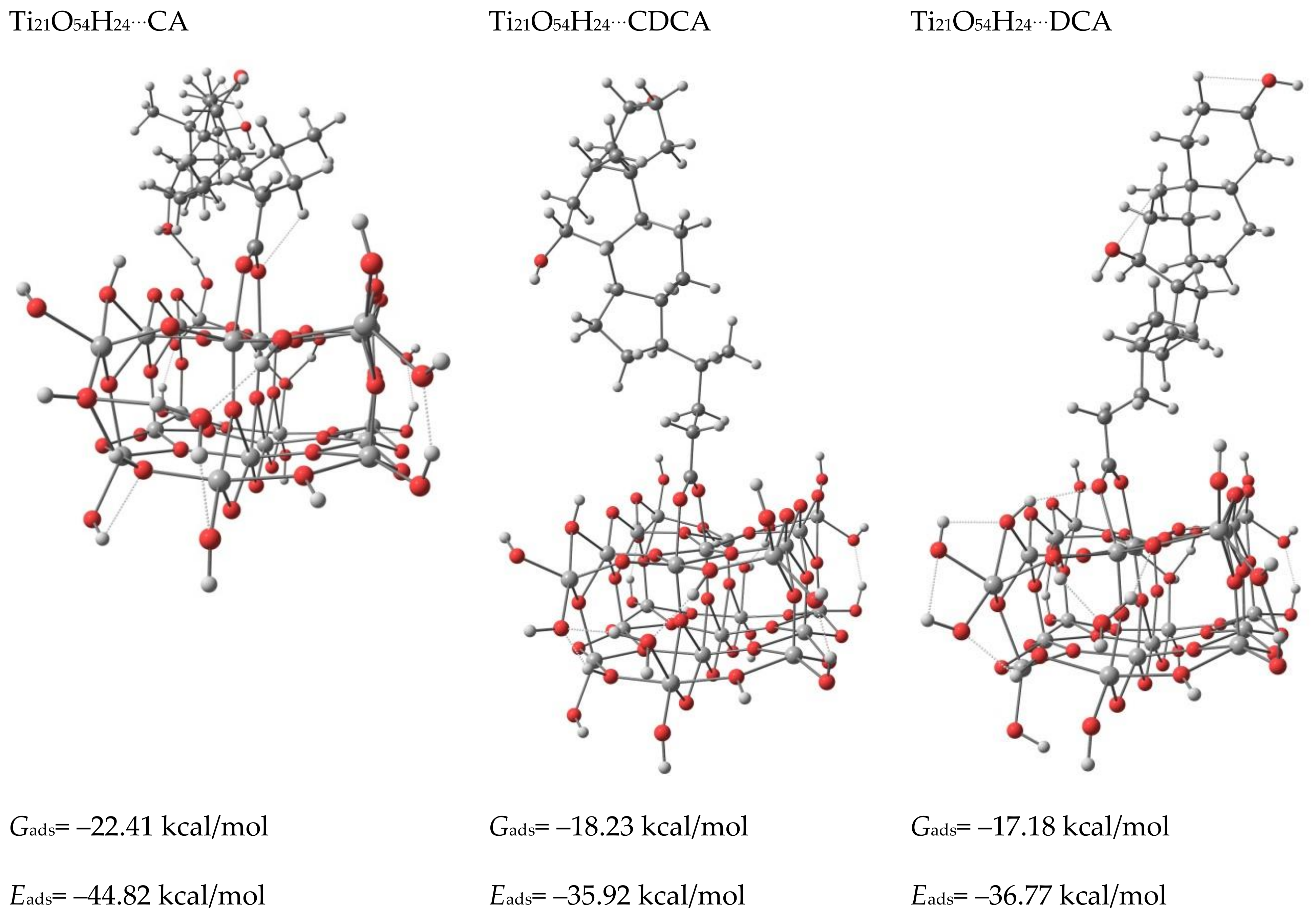

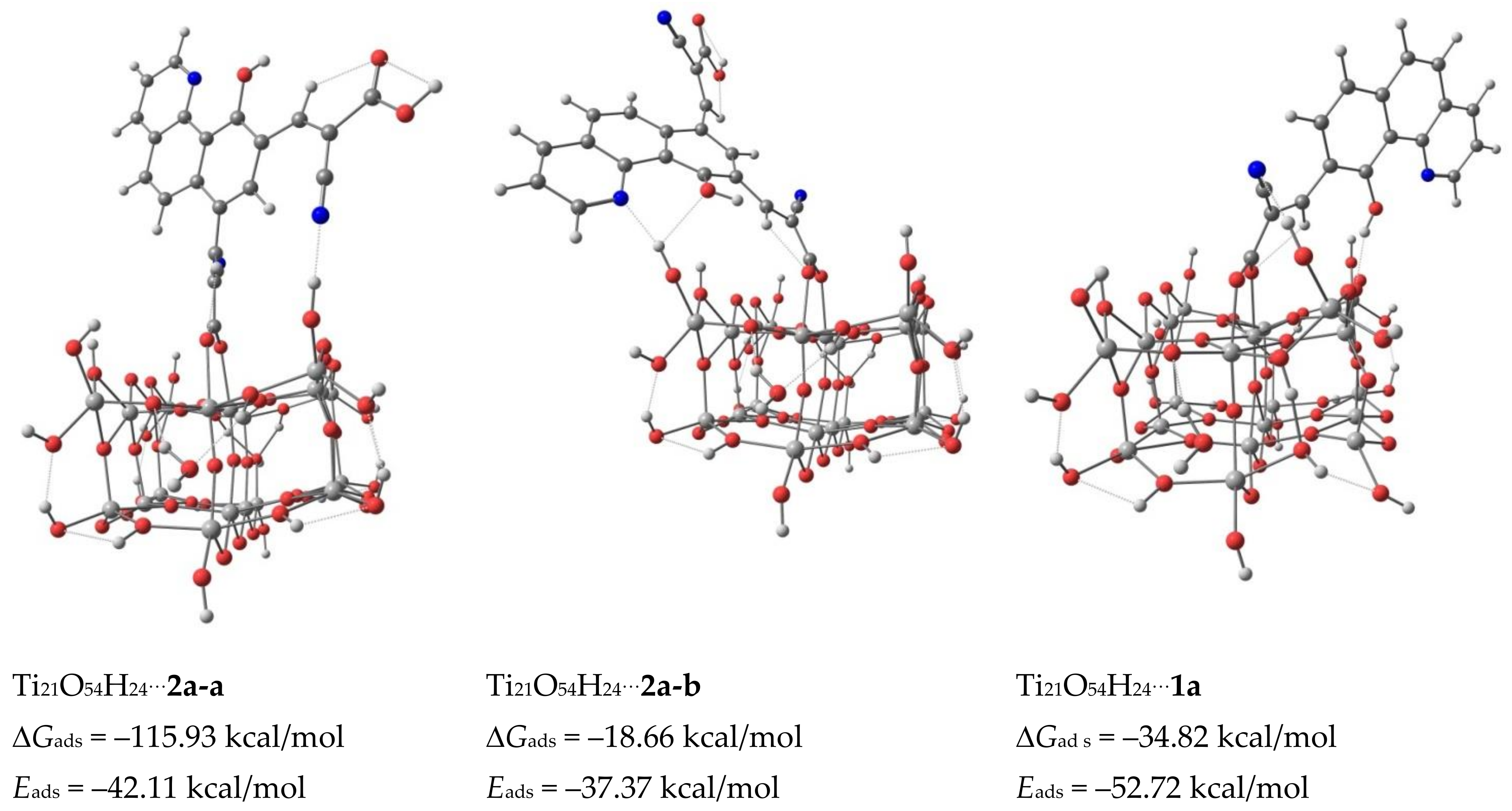
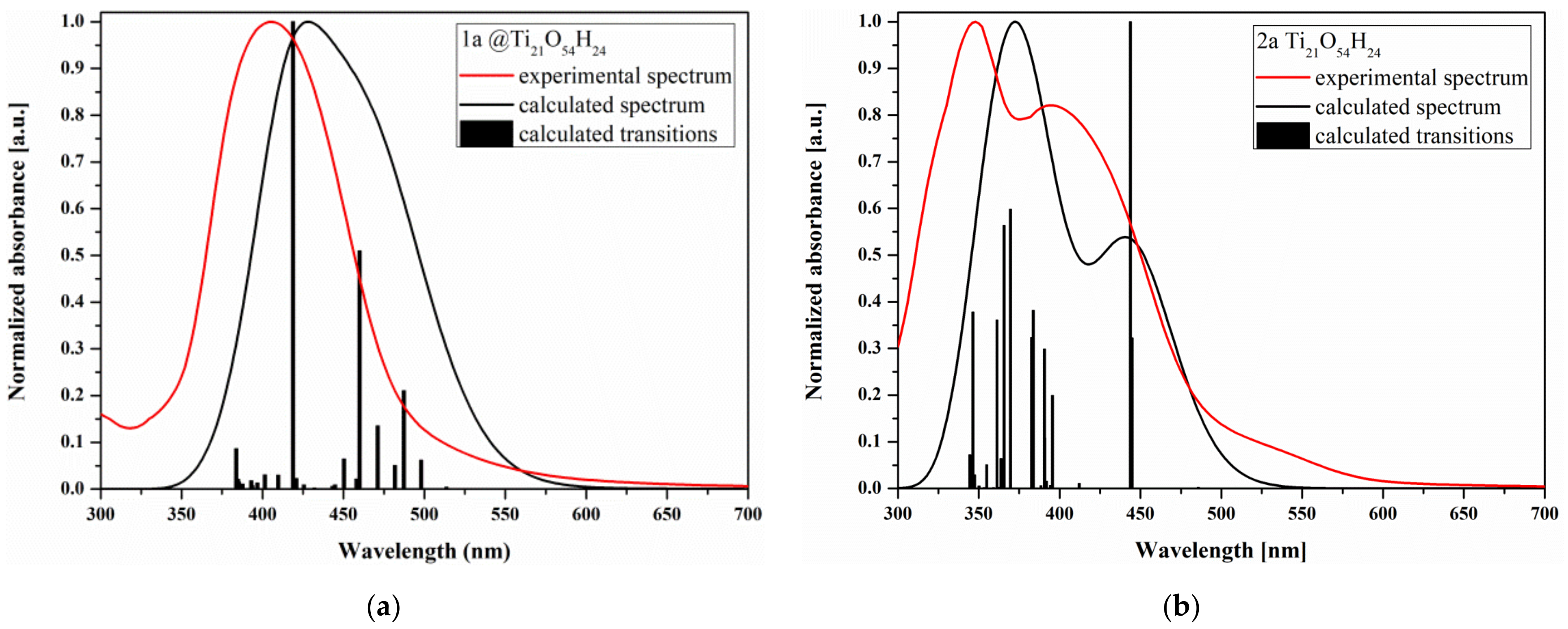
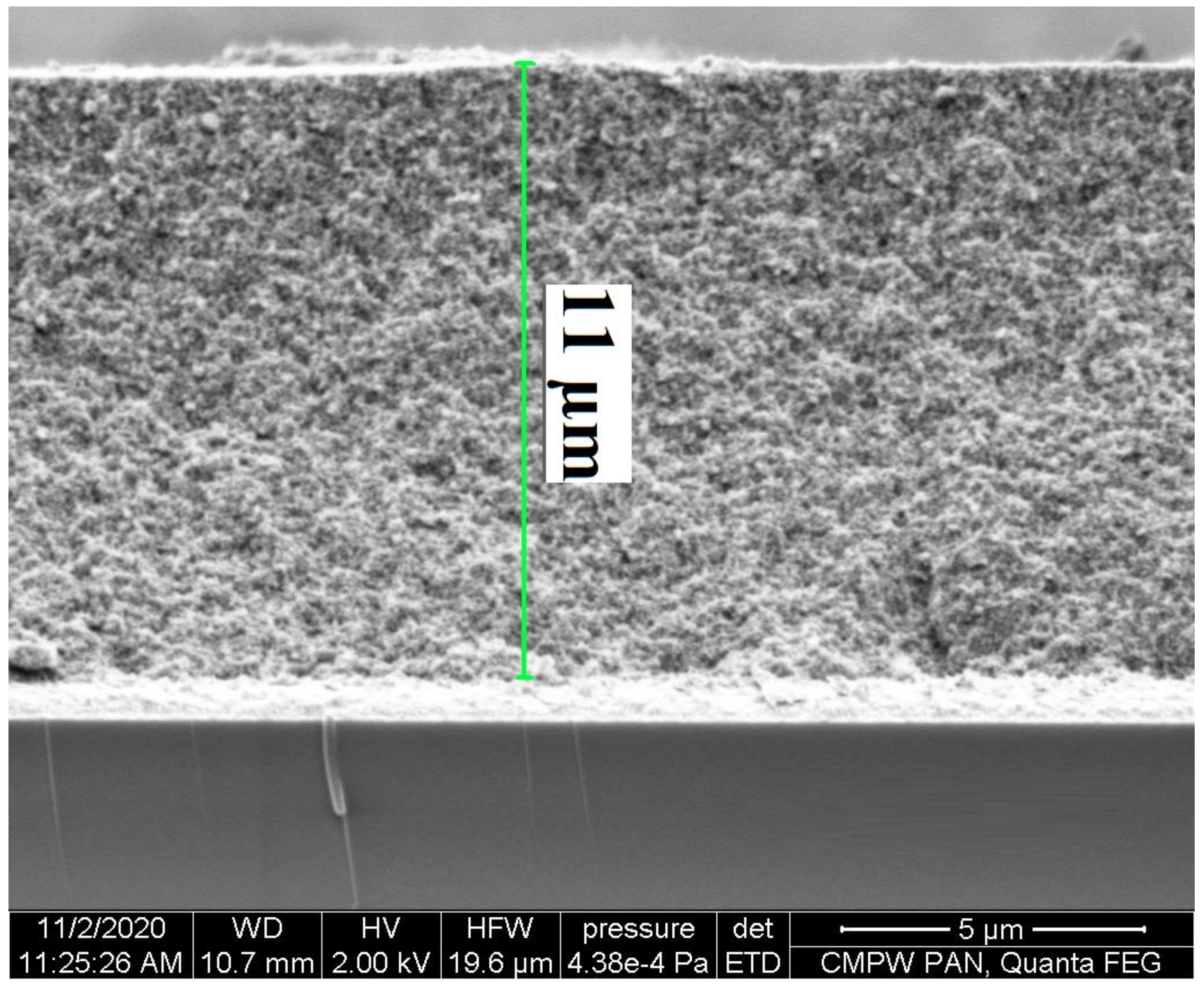
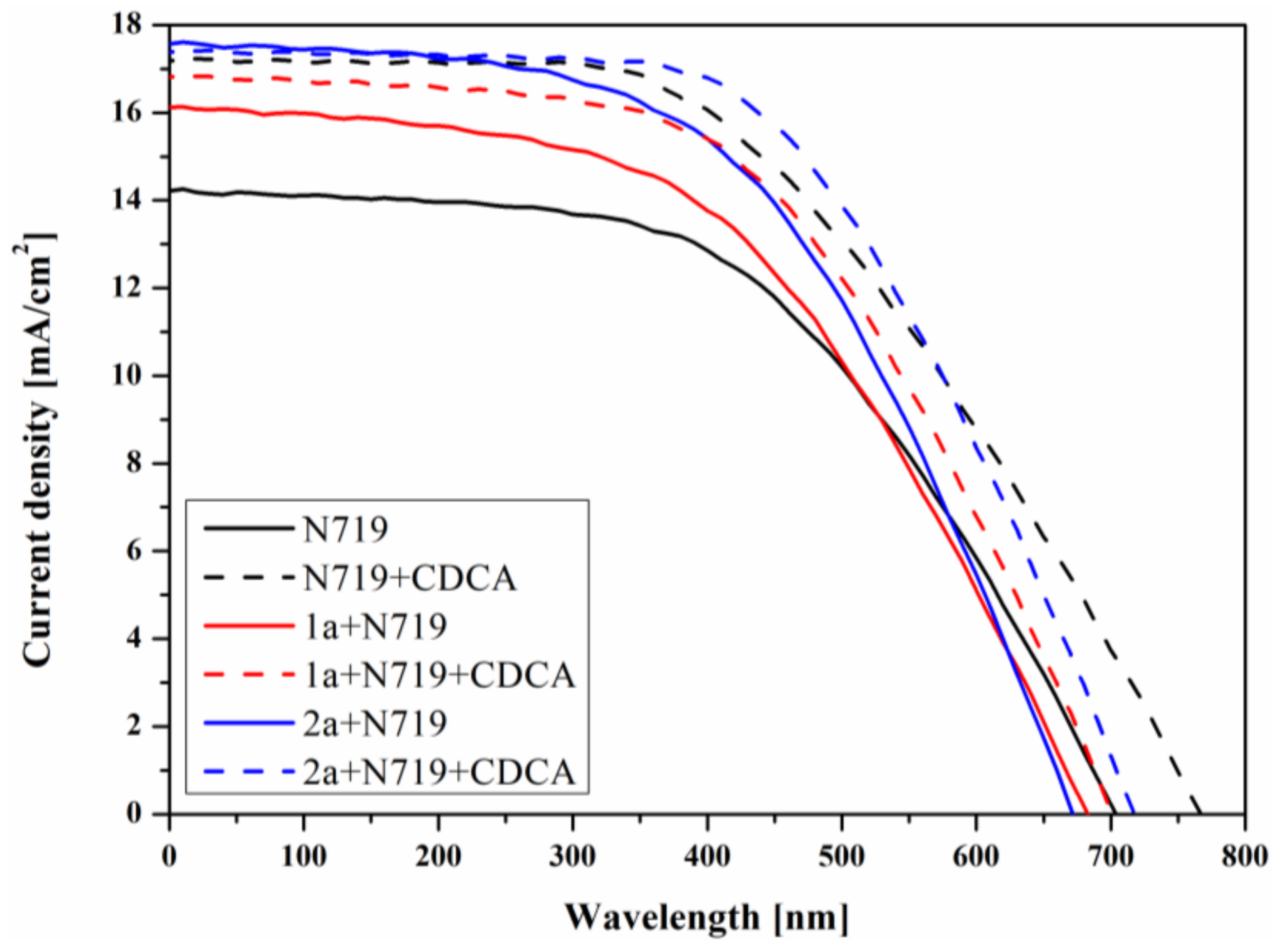

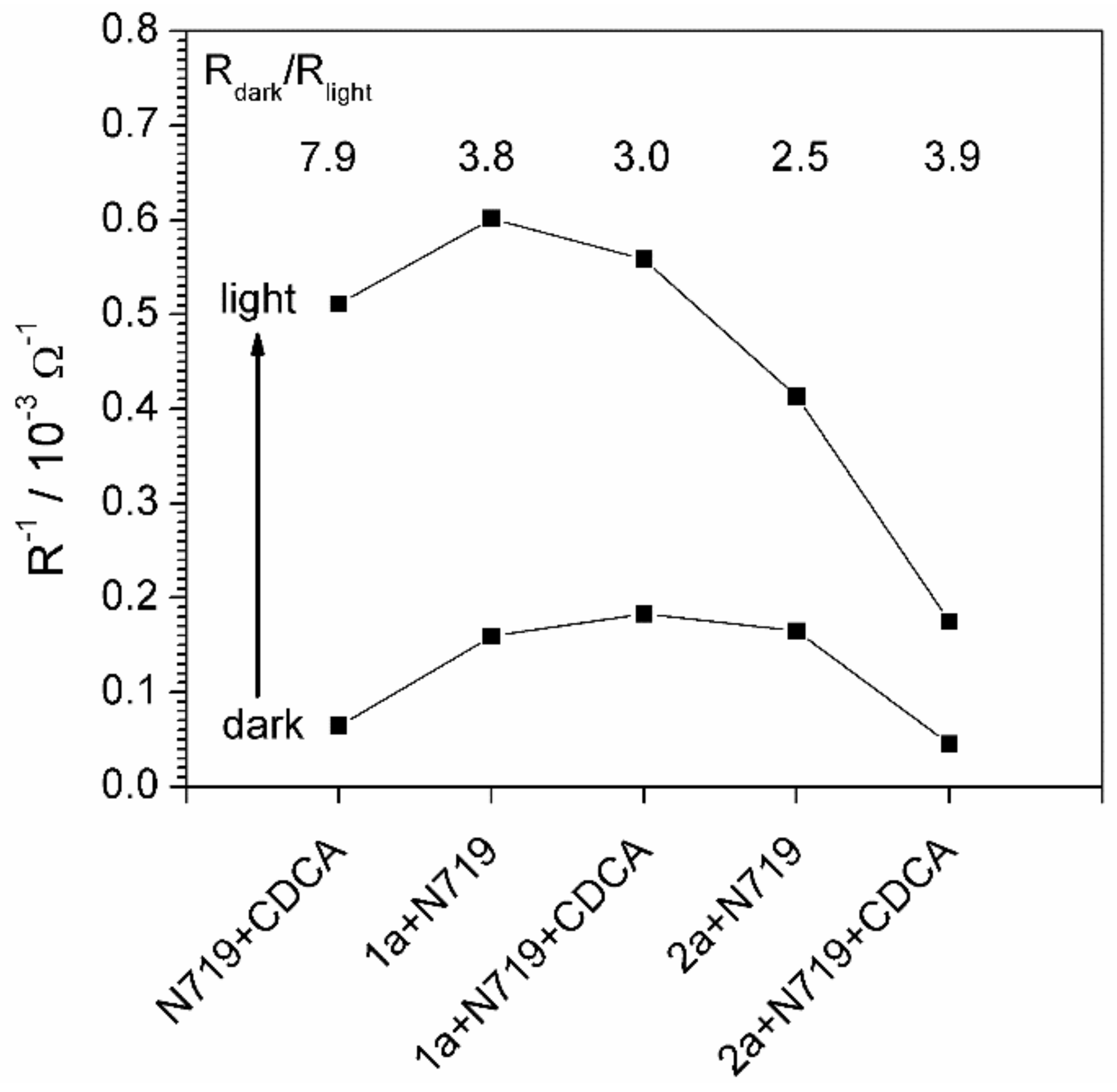
| Solvent | λmax (nm) (ε (M−1cm−1)) | PL λem (nm) | τeff (τ (ns) (Weight%)) | Φ (%) | EgOPT (eV) | |||||
|---|---|---|---|---|---|---|---|---|---|---|
| 1a | 2a | 1a | 2a | 1a | 2a | 1a | 2a | 1a | 2a | |
| MeOH | 275(10,880), 327(4635), 393(5085) | 273(23,896), 366(13,600), 383 (12,727) | 418, 611 | 413, 601 | 5.56 [1.65 (21.24), 6.62(78.76)] | 5.97 [1.71(12.94), 6.60(87.06)] | 0.07 | 0.15 | 2.97, 2.03 | 3.00, 2.06 |
| DMF | 276(16,000), 328(6000), 391(6667) | 289(10,000), 354(10,667), 407(10,000) | 430, 626 | 411, 610 | 4.24 [1.19(39.9), 6.26(60.1)] | 4.57 [1.17(45.04), 7.35(54.96)] | 1.13 | 1.25 | 2.89 | 3.02, 2.03 |
| Photoanode | AFM | SEM | Optical Microscope | ||
|---|---|---|---|---|---|
| RMS (nm) | Thickness (µm) | Thickness (µm) | Sq (µm) | Sku | |
| TiO2 + 1a | 32 | 9 | 8 | 0.459 | 4.159 |
| TiO2 + 2a | 33 | 10 | 10 | 0.319 | 4.707 |
| TiO2 + 1a + N719 | 29 | 8 | 9 | 0.383 | 4.331 |
| TiO2 + 2a + N719 | 31 | 11 | 10 | 0.311 | 4.924 |
| TiO2 + 1a + N719 + CDCA | 35 | 12 | 12 | 0.598 | 5.479 |
| TiO2 + 2a + N719 + CDCA | 37 | 11 | 12 | 0.635 | 5.654 |
| Photoanode Sensitized with | Voc (V) | Jsc (mA cm−2) | FF (–) | PCE (%) |
|---|---|---|---|---|
| N719 | 0.703 (±0.004) | 14.28 (±0.03) | 0.53 (±0.02) | 5.35 (±0.04) |
| N719 + CDCA | 0.762 (±0.003) | 17.20 (±0.05) | 0.50 (±0.01) | 6.90 (±0.07) |
| 1a | 0.475 (±0.006) | 0.30 (±0.03) | 0.49 (±0.02) | 0.07 (±0.01) |
| 2a | 0.567 (±0.002) | 1.38 (±0.02) | 0.57 (±0.01) | 0.44 (±0.02) |
| 1a + N719 | 0.680 (±0.002) | 16.12 (±0.01) | 0.51 (±0.01) | 6.02 (±0.03) |
| 2a + N719 | 0.670 (±0.002) | 17.57 (±0.03) | 0.53 (±0.01) | 6.38 (±0.04) |
| 1a + N719 + CDCA | 0.700 (±0.003) | 16.94 (±0.08) | 0.53 (±0.01) | 6.42 (±0.08) |
| 2a + N719 + CDCA | 0.716 (±0.001) | 17.44 (±0.04) | 0.57 (±0.01) | 7.22 (±0.04) |
| Dark | Light | |||||
|---|---|---|---|---|---|---|
| Compound | Rs/Ω | R1/kΩ | C1/μF | Rs/Ω | R1/kΩ | C1/μF |
| N719 + CDCA | 16.0 | 15.5 | 16.1 | 31.1 | 1.96 | 21.5 |
| 1a + N719 | 19.9 | 6.28 | 18.0 | 16.7 | 1.66 | 19.1 |
| 2a + N719 | 18.8 | 6.07 | 18.4 | 17.3 | 2.42 | 20.4 |
| 1a + N719 + CDCA | 37.8 | 5.45 | 19.1 | 22.3 | 1.79 | 21.6 |
| 2a + N719 + CDCA | 21.6 | 2.22 | 16.2 | 19.7 | 5.72 | 18.6 |
Publisher’s Note: MDPI stays neutral with regard to jurisdictional claims in published maps and institutional affiliations. |
© 2021 by the authors. Licensee MDPI, Basel, Switzerland. This article is an open access article distributed under the terms and conditions of the Creative Commons Attribution (CC BY) license (https://creativecommons.org/licenses/by/4.0/).
Share and Cite
Slodek, A.; Gnida, P.; Małecki, J.G.; Szafraniec-Gorol, G.; Chulkin, P.; Vasylieva, M.; Nycz, J.; Libera, M.; Schab-Balcerzak, E. New Benzo[h]quinolin-10-ol Derivatives as Co-sensitizers for DSSCs. Materials 2021, 14, 3386. https://doi.org/10.3390/ma14123386
Slodek A, Gnida P, Małecki JG, Szafraniec-Gorol G, Chulkin P, Vasylieva M, Nycz J, Libera M, Schab-Balcerzak E. New Benzo[h]quinolin-10-ol Derivatives as Co-sensitizers for DSSCs. Materials. 2021; 14(12):3386. https://doi.org/10.3390/ma14123386
Chicago/Turabian StyleSlodek, Aneta, Paweł Gnida, Jan Grzegorz Małecki, Grażyna Szafraniec-Gorol, Pavel Chulkin, Marharyta Vasylieva, Jacek Nycz, Marcin Libera, and Ewa Schab-Balcerzak. 2021. "New Benzo[h]quinolin-10-ol Derivatives as Co-sensitizers for DSSCs" Materials 14, no. 12: 3386. https://doi.org/10.3390/ma14123386
APA StyleSlodek, A., Gnida, P., Małecki, J. G., Szafraniec-Gorol, G., Chulkin, P., Vasylieva, M., Nycz, J., Libera, M., & Schab-Balcerzak, E. (2021). New Benzo[h]quinolin-10-ol Derivatives as Co-sensitizers for DSSCs. Materials, 14(12), 3386. https://doi.org/10.3390/ma14123386






